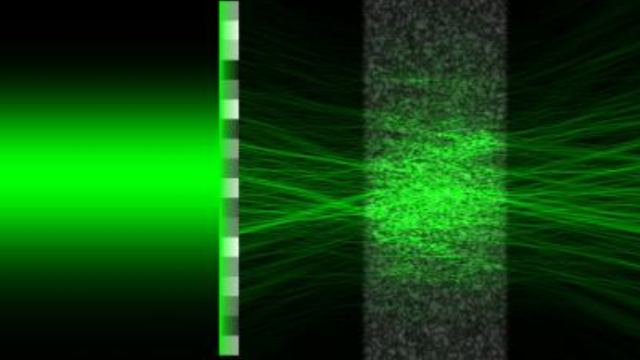It’s not quite seeing through walls, but scientists are working to engineer light beams so that they can pass through an opaque medium without scattering, according to a new paper.
When you shine headlights through a fog, they scatter or reflect and the beam spreads out. But there are times when scientists really need to pass a beam through something without all that diffusion. A team of physicists is working on fine-tuning waves so they can pass through things like white paint and even human skin for potential medical and communications applications.
“If we want to deliver a laser pulse deeply into a tissue, we can prevent the light spreading so that it can be more concentrated,” study principle investigator Hui Cao from Yale University told Gizmodo. “Or to send a laser through a cloud or fog, we want to keep the beam concentrated so the energy can get to a detector without spreading out.”
Researchers have long wondered how to send beams, either of particles like electrons or of light, through otherwise opaque materials. These materials can scatter and reflect light such that none of it passes through to the other side. However, recent advances have shown that specially tailored beams could transmit energy through opaque materials by travelling in just the right way, such that some of the waves in the beam cancel out while others add together upon entering the medium.
The researchers behind the new paper were hoping to do more than just pass all the light through, though. They also wanted to produce a focused beam on the other side of the material.
Producing their specially tuned beam first required a bit of maths. The researchers made a simplified model of the opaque medium — in this case a slide covered with white zinc oxide paint — and calculated how the front of the wave should be shaped using a process you might call “guess, check, and revise.”
After solving their equation, they used something called a spatial light modulator to produce the correct wave front, shone it onto the painted slide, and successfully produced outputs that were thinner than an ordinary beam would produce. A random beam 13 micrometres wide that passed through the medium produced an output 21 micrometres in diameter, but a specially produced 10-micrometre beam produced a spot 14 micrometres wide, according to the paper published in Nature Photonics. In other words, the custom light beam remained relatively concentrated even after passing through the white paint.
It might seem like magic, but Cao pointed out that they need to tailor the light beam to each material they’d like to pass it through, and that takes time. “We were thinking we could combine this with machine learning to learn about the system quickly in a few measurements, and use it to find the correct wave front,” she said. “It probably always needs to be tuned for specific systems. The question is how fast we can do it.” They also hope to make an even more concentrated beam on the other side of the medium.
With this advance, it is in fact possible to shine lasers through walls—but only very specific kinds of walls. Hopefully, the list of walls increases soon.
